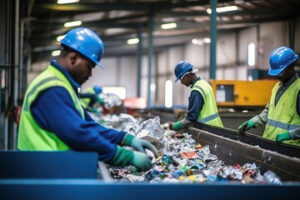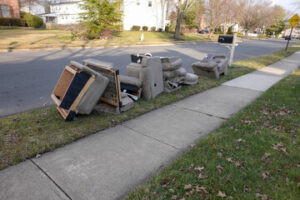Waste Recycling involves the conversion of organic and inorganic materials to new products rather than incineration or dumping into landfills. Incineration releases carbon dioxide and other harmful pollutants into the air while landfills release methane and volatile organic compounds that contaminate groundwater, soil, and crops.
The benefits of Waste Recycling by Rubbish Removal Perth are both economic and social. Efficient practices in resource use, treatment, and disposal can lead to more jobs and less pollution.

Recycling Saves Energy
All sorts of materials can be recycled into new products — paper, plastics, aluminum, and glass. But recycling also helps conserve the natural resources that are used to make the original products – such as timber, water, and oil. This cuts down on the need to extract and process raw materials from the earth, which requires a lot of energy.
The most common recyclable materials are aluminum cans, copper wire, steel furniture or equipment, scrap metals, rubber tires, and polyethylene and PET bottles. These are relatively simple items, made from a single type of material, and therefore fairly easy to turn into new products. However, more complex items like computers and electronic equipment (or e-waste) are more difficult to recycle. E-waste contains a mix of different materials and is typically heavy, so requires special treatment and transport to recycling plants. However recycling these e-waste items is still important because it helps to reduce the amount of toxic chemicals and heavy metals that enter the environment, where they can contaminate soil and water and cause harm to animals and humans.
Many people think of recycling as a way to protect the environment, but it is a great way to save energy too. The processing of new raw materials requires a lot of energy, as does transporting them to factories and then the manufacturing of products. And when the waste is burned or sent to landfill, it releases gases into the atmosphere that contribute to climate change. Recycling reduces the need for all these processes, which in turn saves energy and cuts down on greenhouse gas emissions.
A lot of the stuff we throw away is a result of our consumption of modern consumer goods – things like cell phones, computers, and inkjet cartridges. But when these items are recycled, they can be turned into new products that will last longer, so we’re not wasting as much of them. This in turn helps to preserve natural habitats, forests, and rainforests for future generations and gives the earth a chance to recover from our use of it.
Recycling Saves Water
While recycling generally refers to repurposing products like aluminum cans and glass bottles, it also can include water. Water recycling, or water reclamation, is the reuse of wastewater for things like landscape irrigation, toilet flushing, and replenishing groundwater basins. This type of recycling conserves fresh water, saves energy on filtration and treatment costs, and can increase infrastructure capacity for new users.
Overflowing landfills are a major problem around the world. They release greenhouse gases like methane, contribute to smog and air pollution, and can contaminate nearby water sources. Recycling keeps waste materials out of landfills, which prevents the release of toxic chemicals and methane into the atmosphere, reduces pollution risks, and preserves natural resources.
During the recycling process, used materials are separated into components. Those components can then be turned into new products, either identical to the original or something completely different. Reusing metals, for example, can eliminate the need to extract and process new tin or other raw materials. Recycling paper can cut production costs, and reprocessing scrap steel can avoid the need to mine, transport, and manufacture virgin material.
Preserving natural resources is a key reason why people recycle. Our finite reserves of non-renewable natural resources are being depleted rapidly, especially as we continue to produce and consume disposable products and packaging. By repurposing materials, recycling conserves these resources and helps to ensure we do not exceed our resource limits.
Recycling diverts many materials from landfills and incinerators, which can harm the environment. Landfills and incinerators consume valuable space that could be put to economic use while dumping waste into the environment damages ecosystems and can harm human health. Recycling helps to protect our planet, supports local economies, and encourages a more eco-friendly lifestyle.
Ultimately, the choice to recycle is one that each person makes on their own. It requires some extra effort and commitment on our part, but the benefits are clear: it saves energy and natural resources, supports local economies, promotes a greener lifestyle, and creates jobs. As such, it is an excellent alternative to other means of waste disposal and a crucial step in protecting our environment for future generations.
Recycling Saves Money
Businesses generate a lot of waste, and it can add up quickly. The good news is that recycling can help you save money in the long run. It helps reduce your energy costs, and it also allows you to cut down on waste disposal expenses.
When you recycle, you’re using existing materials to make new products instead of relying on fresh raw materials. This conserves valuable natural resources, such as lumber, water, and minerals, while reducing the need to extract new ones. It also helps cut down on the amount of pollution and emissions that are produced during production.
In addition, it takes significantly less energy to produce recycled goods than it does to create them from scratch. For example, it requires 96 percent less energy to make aluminum cans from recycled material than it does to extract the raw material bauxite. The same is true for other types of recyclables, such as glass and paper.
The savings don’t stop there. Recycled products are also cheaper for manufacturers to purchase than raw materials. This can help them keep their prices down for consumers, which is a great way to increase sales.
Even if you don’t have a dedicated recycling program at your business, you can still save money by doing things like reusing shipping materials, buying reusable items instead of disposable ones, and setting up labeled bins for trash and recyclables around your workplace. This will help you reduce your waste hauling and disposal costs, as well as cut down on space and labor.
If you want to save even more, consider switching out your old light bulbs for ENERGY STAR compact fluorescent bulbs. These can save you up to $6 per year and $40 throughout their lifetimes.
Recycling is a cost-effective solution for both individuals and companies. By reducing the amount of trash that goes to landfills, we can save on waste disposal fees, which in turn will lower taxes and other expenses for local governments and waste management companies.
Recycling Saves The Environment
The most obvious way that recycling saves the environment is by diverting waste away from overflowing landfills that destroy nearby ecosystems and release toxic chemicals into the air, water, and soil. But the benefits of recycling extend well beyond that. By using recycled materials to make new products, manufacturers can reduce their energy consumption, greenhouse gas emissions, and pollution.
When people recycle paper, cardboard, glass bottles and jars, metal cans, inkjet cartridges, aluminum foil, plastic containers, and even old computers, they reduce the need to harvest or extract raw materials from the environment. This reduces the harmful disruption and damage that occurs when wild animals are hunted or harmed to harvest raw materials; forests are burned, rivers are dammed and diverted, and people are displaced as they search for resources.
It also reduces the need to drill for oil, mine for coal, and other fossil fuels that pollute the environment during their production. It reduces the need to cut down more trees; by reducing the amount of paper we consume, for example, only 20% more wood needs to be harvested. By recycling plastic, we can avoid the need to cut down more trees and create new jobs in local communities.
In addition, by avoiding the need to look for and obtain new raw materials, recycling reduces the environmental impacts of extracting or drilling for new materials and shipping them around the world. This is especially true when the raw materials are shipped to distant locations to be made into new products. For example, producing recycled aluminum requires 95% less energy than making it from raw materials.
Landfills decompose anaerobically, meaning they lack oxygen and produce methane, a potent greenhouse gas that is linked to global warming. Recycling paper, for example, cuts down on methane production by a whopping 60%. By cutting down on the need to extract and process new raw materials, recycling reduces greenhouse gas emissions that contribute to climate change and provides a source of renewable energy.
It also reduces the need to transport these raw materials to where they are needed, which means fewer trucks on the road and less carbon dioxide released into the atmosphere. Finally, it reduces the need for incinerators, which pollute the environment with smoke and other pollutants.
